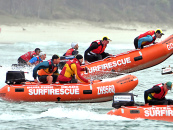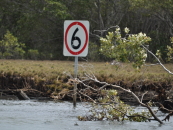The Transport Operations (Marine Safety) Act 1994 (Qld) imposes a general safety obligation on all vessel owners, operators, masters and crew. The general safety obligations include ensuring that the vessel is safe, properly equipped and maintained, and that it is operated in a safe manner, including proceeding at a safe speed.
Are you ‘up to speed’ when it comes to taking your boat out on Queensland’s waters? Find out by taking our quiz.
QUESTION 1 – WHAT SPEED RESTRICTIONS ARE IN PLACE ON THE GOLD COAST FOR BOATS?
a. A speed limit of 6 knots within 60 metres of: ● boats that are anchored, moored or aground ● a jetty, wharf, pontoon or boat ramp. ● people in the water
b. There is no actual speed limit – you just need to make sure the vessel is operated safely and it is properly equipped.
c. A speed limit of 6 knots within 30 metres of: ● boats that are anchored, moored or aground ● a jetty, wharf, pontoon or boat ramp ● people in the water
The answer is c. This speed limit is called an operational “distance-off” speed limit. Remember, these restrictions apply whether or not there are speed limit signs.
If you ride a personal watercraft (jet ski), the operational “distance-off” speed limit is different to when operating a boat. Instead there is a speed limit of 6 knots within 60 metres of:
● boats that are anchored, moored or aground
● jetties, wharfs, pontoons and boat ramps
● the shoreline or the boundary of a bathing reserve
● people in the water
QUESTION 2 – WHO ENFORCES SPEED LIMITS ON GOLD COAST WATERS?
a. The Queensland Water Police, and Queensland Boating and Fisheries Patrol.
b. The Queensland Water Police.
c. The Gold Coast Waterways Authority, and the Queensland Water Police.
The answer is a. The Queensland Water Police and Queensland Boating and Fisheries Patrol enforce boating speed limits in Queensland. On the Gold Coast, it is the Gold Coast Waterways Authority that is responsible for setting and managing the speed limits on Gold Coast waterways.
Remember, you can report speeding or unsafe on-water behavior to the Queensland Water Police either online or by calling 131 444, or you can contact the Queensland Boating and Fisheries Patrol on 13 25 23.
QUESTION 3 – YOU HAVE BEEN STOPPED BY THE WATER POLICE AS YOU WERE SPEEDING IN YOUR BOAT IN AN AREA WHERE AN OPERATIONAL “DISTANCE-OFF” SPEED LIMIT APPLIES. WHAT IS LIKELY TO HAPPEN NEXT?
a. It’s the first time you have been stopped by the Water Police, so you will just get a warning.
b. You could be given a marine infringement notice (MIN) with a fine of $400.35.
c. You could be fined up to $26,690.
d. You could be fined up to $6,690.
The answer is b or c, at the discretion of police or QBFP. If you get caught speeding in a boat or personal watercraft in an area where an operational “distance-off” speed limit applies, the maximum fine that could be applied is 200 penalty units, which is the equivalent of a fine of up to $26,690 (1 penalty unit is $133.45), under sections 81 and 82 of the Transport Operations (Marine Safety) Regulation 2016 (Qld). The State Penalties Enforcement Regulation 2019 allows the issue of an MIN for 3 penalty units for each of these offences.
QUESTION 4 – EVEN THOUGH YOU WERE OPERATING YOUR BOAT WITHIN THE SPEED LIMIT SHOWN ON THE SPEED SIGN, THE WATER POLICE HAVE STOPPED YOU AS YOU HAVE CREATED A WASH THAT HAS IMPACTED OTHER BOATS IN THE AREA. WHAT IS LIKELY TO HAPPEN NEXT?
a. You could be given a marine infringement notice (MIN) with a fine of $400.35.
b. You could be fined up to $26,690.
c. You weren’t exceeding the speed limit so the Water Police cannot fine you.
d. The Water Police will tell you to keep an eye on your wash in future.
The answer is a or b at the discretion of the water police. Even if you are travelling at or below the speed limit, boats and personal watercraft still cause a wash, and the waves may cause damage or injury. Under section 83 of the Transport Operations (Marine Safety) Regulation 2016 (Qld) if you operate a vessel at a speed at which the vessel’s wash is reasonably capable of causing a marine incident or damage to the shoreline, you could be fined up to a maximum of 200 penalty units, which is the equivalent of a fine of up to $26,690 (1 penalty unit is $133.45). The State Penalties Enforcement Regulation 2019 allows the issue of an MIN for 3 penalty units for this offence. Remember, always take a look at your wash behind you. Be aware of any impact you could have on other boats, pontoons, people in the water or the shore, and adjust your speed accordingly.
By Claire Strodder , Maritime Lawyer
Published in the April – July 2020 print edition.



























